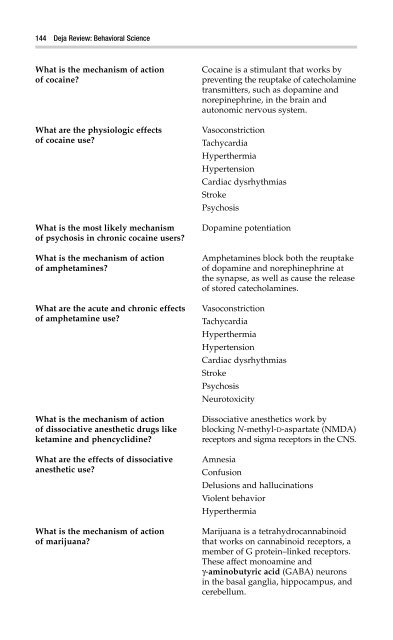Behavioral Science
You also want an ePaper? Increase the reach of your titles
YUMPU automatically turns print PDFs into web optimized ePapers that Google loves.
142 Deja Review: <strong>Behavioral</strong> <strong>Science</strong><br />
What are the major problems with<br />
using positive and negative<br />
reinforcement treatments?<br />
What is the basic principle behind<br />
detoxification?<br />
What percentage of patients who<br />
become drug-free relapse?<br />
What modalities have been associated<br />
with decreased incidence of relapse?<br />
What is the most likely reason<br />
for relapse?<br />
How can cravings be treated to prevent<br />
relapse?<br />
What are some of the medical effects<br />
of drug abuse?<br />
To use positive reinforcement<br />
treatments, the patient must undergo<br />
detoxification first.<br />
Negative reinforcement treatments<br />
may lead to polydrug abuse,<br />
especially if substitution methods<br />
are used.<br />
Detoxification uses the principle of<br />
substitution with a drug of crossdependence<br />
or different route of<br />
administration to allow for safer,<br />
slower withdrawal from the drug<br />
of dependence. It should not be<br />
used to precipitate withdrawal.<br />
75%—most within the first year<br />
Joining self-help groups → providing<br />
a different type of peer pressure and<br />
reinforcement<br />
Cognitive therapy → helps develop<br />
new and different coping skills<br />
Cravings is the most common reason<br />
for relapse. Cravings are caused by<br />
memories of the positive rewards of<br />
drug use or by conditioning cues that<br />
are endogenous or exogenous.<br />
Cravings may be treated by reducing<br />
the desire for the drug, providing a<br />
substitute for the drug reward, reducing<br />
endogenous cues for cravings (ie, by<br />
using anxiolytics or antidepressants),<br />
reducing the conditional anticipation<br />
of the reward (ie, giving naltrexone<br />
to an alcoholic), or by reducing<br />
pseudowithdrawal symptoms.<br />
Increased risk of lung disease<br />
and cancer<br />
Increased risk of human<br />
immunodeficiency virus (HIV),<br />
hepatitis, and other infections with<br />
intravenous (IV) drug use<br />
Acute and chronic toxicities



